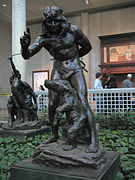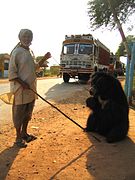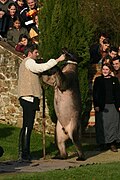Tame bear

A tame bear, often called a dancing bear, is a wild bear captured when young, or born and bred in captivity, and used to entertain people in streets or taverns. Dancing bears were commonplace throughout Europe and Asia from the Middle Ages to the 19th century, and can still be found in the 21st century in some countries.
Dancing bears
[edit]Training methods
[edit]One method to get the bear used to standing on its hind feet was to constantly feed it from above.[1] Another was to make a hole through the animal's mouth or nose and pull it upright.[1] To make it dance the animal might be put on a hot plate while music was played to condition it to move its feet when it heard music in future.[1] Bears might also be starved in an attempt to render them less aggressive.[1]
History
[edit]In Ancient Rome, bears and monkeys were led to dance and perform tricks for the public.[2] The practice was banned in the UK in 1911.[3] Dancing bears were commonplace in the Indian subcontinent for centuries. Dancing bears were banned in India under the 1972 Wildlife Protection Act.[4] The last of them were freed in 2009.[5]
In Russia and Siberia, cubs were for centuries captured for being used as dancing bears accompanying tavern musicians (skomorokhi), as depicted in the Travels of Adam Olearius.[6] Dancing bears were widespread throughout Europe from the Middle Ages to the 19th century. They were still present on the streets of Spain in 2007,[7] and in Eastern Europe.
Recently, organizations and animal rights activists have worked to outlaw or eliminate tame bears, since the practice is seen as cruel and antiquated, citing mistreatment and abuse used in order to train the bears.[8][9]
French bear handlers
[edit]Traveling with a bear was very popular in France at the end of the 19th century, between 1870 and 1914. More than 600 men from Ariège in the French Pyrenees trained bear cubs found in the mountains near their home. Among them, 200 traveled to North America arriving at the ports of New York, Quebec, Montreal and Halifax from the ports of Liverpool, Glasgow and Belfast.[10] They would leave their home early in spring, walking from the Pyrenees through France and England, earning money for the crossing in order to arrive in North America in May or June.
Gallery
[edit]-
Engraving with dancing bear from Adam Olearius's Travels, 1647
-
Bohemian Bear Tamer, 1888 cast by Paul Wayland Bartlett
-
Josephine the Bear in Woods Hole, Massachusetts, c. 1915
-
A dancing bear in Pushkar, India, 2003
-
Dancing bear in France, 2007
See also
[edit]References
[edit]- ^ a b c d Bieder, Robert E. (2005-08-18). Bear. London: Reaktion Books. pp. 106–110. ISBN 1-86189-204-7.
- ^ Pelin Tünaydın. "Pawing through the History of Bear Dancing in Europe" (PDF). Frühneuzeit-Info.
- ^ Bieder, Robert E. (2005-08-18). Bear. London: Reaktion Books. p. 110. ISBN 1-86189-204-7.
- ^ "Charity frees 'last' dancing bear". BBC News. 20 December 2009. Retrieved 31 August 2024.
- ^ "Last Indian dancing bear set free". BBC News. 18 December 2009. Retrieved 4 January 2017.
- ^ Findeizen, Nikolai (2008). History of Music in Russia from Antiquity to 1800, Vol. 1: From Antiquity to the Beginning of the Eighteenth Century. Indiana University Press. p. 201. ISBN 978-0-253-02637-8.
- ^ Neale, Adam (16 October 2007). "Dancing bears in Spain cause public outcry". The Olive Press. Retrieved 4 January 2017.
- ^ "Dancing bears". Bear Conservation. Retrieved 2020-11-09.
- ^ "Traveling Bear Shows: Abuse and Neglect On Tour". PETA. 2017-10-30. Retrieved 2020-11-09.
- ^ Louise Pagé, The Man behind the Dancing Bear, amazon.ca, ISBN 9782981754516





